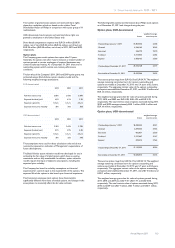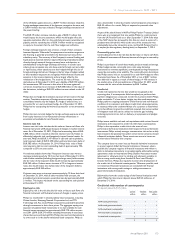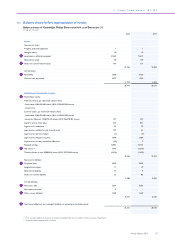Philips 2011 Annual Report Download - page 173
Download and view the complete annual report
Please find page 173 of the 2011 Philips annual report below. You can navigate through the pages in the report by either clicking on the pages listed below, or by using the keyword search tool below to find specific information within the annual report.
12 Group financial statements 12.11 - 12.11
Annual Report 2011 173
of the US dollar against the euro, a EUR 14 million decrease related to
foreign exchange transactions of the Japanese yen against the euro, and
a EUR 10 million decrease related to foreign exchange transactions of
the pound sterling.
The EUR 19 million increase includes a gain of EUR 21 million that
would impact the income statement, which would largely offset the
opposite revaluation effect on the underlying accounts receivable and
payable, and the remaining loss of EUR 3 million would be recognized
in equity to the extent that the cash flow hedges were effective.
Foreign exchange exposure also arises as a result of inter-company
loans and deposits. Where the Company enters into such arrangements
the financing is generally provided in the functional currency of the
subsidiary entity. The currency of the Company’s external funding and
liquid assets is matched with the required financing of subsidiaries either
directly through external foreign currency loans and deposits, or
synthetically by using foreign exchange derivatives. In certain cases
where group companies may also have external foreign currency debt
or liquid assets, these exposures are also hedged through the use of
foreign exchange derivatives. Changes in the fair value of hedges related
to this translation exposure are recognized within financial income and
expenses in the income statement and are largely offset by the
revaluation of the hedged items. The total net fair value of these
derivatives as of December 31, 2011, was a liability of EUR 518 million.
An instantaneous 10% increase in the value of the euro against all
currencies would lead to an increase of EUR 388 million in the value of
the derivatives, including a EUR 329 million increase related to the US
dollar.
Philips does not hedge the translation exposure of net income in foreign
entities. Translation exposure of foreign-currency equity invested in
consolidated entities may be hedged. If a hedge is entered into, it is
accounted for as a net investment hedge. As of December 31, 2011,
Philips had no outstanding derivatives accounted for as net investment
hedges.
Philips does not currently hedge the foreign exchange exposure arising
from equity interests in non-functional-currency investments in
associates and available-for-sale financial assets.
Interest rate risk
Interest rate risk is the risk that the fair value or future cash flows of a
financial instrument will fluctuate because of changes in market interest
rates. As of December 31, 2011, Philips had outstanding debt of EUR
3,860 million, which created an inherent interest rate risk. Failure to
effectively hedge this risk could negatively impact financial results. At
year-end, Philips held EUR 3,147 million in cash and cash equivalents,
total long-term debt of EUR 3,278 million and total short-term debt of
EUR 582 million. At December 31, 2011, Philips had a ratio of fixed-
rate long-term debt to total outstanding debt of approximately 73%,
compared to 55% one year earlier.
A sensitivity analysis shows that if long-term interest rates were to
decrease instantaneously by 1% from their level of December 31, 2011,
with all other variables (including foreign exchange rates) held constant,
the fair value of the long-term debt would increase by approximately
EUR 245 million. If there was an increase of 1% in long-term interest
rates, this would reduce the market value of the long-term debt by
approximately EUR 245 million.
If interest rates were to increase instantaneously by 1% from their level
of December 31, 2011, with all other variables held constant, the
annualized net interest expense would decrease by approximately EUR
21 million. This impact was based on the outstanding net cash position
at December 31, 2011.
Equity price risk
Equity price risk is the risk that the fair value or future cash flows of a
financial instrument will fluctuate because of changes in equity prices.
Philips is a shareholder in several publicly listed companies, including
Chimei Innolux, Shenyang Neusoft Corporation Ltd, and TPV
Technology Ltd. As a result, Philips is exposed to potential financial loss
through movements in their share prices. The aggregate equity price
exposure of publicly listed investments in its main available-for-sale
financial assets amounted to approximately EUR 110 million at year-
end 2011 (2010: EUR 270 million including investments in associates
shares that were sold during 2010). Philips does not hold derivatives in
its own stock or in the above-mentioned listed companies. Philips is
also a shareholder in several privately owned companies amounting to
EUR 23 million. As a result, Philips is exposed to potential value
adjustments.
As part of the sale of shares in NXP to Philips Pension Trustees Limited
there was an arrangement that may entitle Philips to a cash payment
from the UK Pension Fund on or after September 7, 2014 if the value
of the NXP shares has increased by this date to a level in excess of a
predetermined threshold, which at the time of the transaction was
substantially above the transaction price, and the UK Pension Fund is
in surplus (on the regulatory funding basis) on September 7, 2014.
Commodity price risk
Commodity price risk is the risk that the fair value or future cash flows
of a financial instrument will fluctuate because of changes in commodity
prices.
Philips is a purchaser of certain base metals, precious metals and energy.
Philips hedges certain commodity price risks using derivative
instruments to minimize significant, unanticipated earnings fluctuations
caused by commodity price volatility. The commodity price derivatives
that Philips enters into are accounted for as cash flow hedges to offset
forecasted purchases. As of December 2011, a loss of EUR 1 million
was deferred in equity as a result of these hedges. A 10% increase in
the market price of all commodities as of December 31, 2011 would
increase the fair value of the derivatives by EUR 1 million.
Credit risk
Credit risk represents the loss that would be recognized at the
reporting date, if counterparties failed completely to perform their
payment obligations as contracted. Credit risk is present within Philips
trade receivables. To have better insights into the credit exposures,
Philips performs ongoing evaluations of the financial and non-financial
condition of its customers and adjusts credit limits when appropriate.
In instances where the creditworthiness of a customer is determined
not to be sufficient to grant the credit limit required, there are a number
of mitigation tools that can be utilized to close the gap including
reducing payment terms, cash on delivery, pre-payments and pledges
on assets.
Philips invests available cash and cash equivalents with various financial
institutions and is exposed to credit risk with these counterparties.
Philips is also exposed to credit risks in the event of non-
performance by financial institutions with respect to financial derivative
instruments. Philips actively manages concentration risk and on a daily
basis measures the potential loss under certain stress scenarios, should
a financial institution default. These worst-case scenario losses are
monitored and limited by the company.
The company does not enter into any financial derivative instruments
to protect against default by financial institutions. However, where
possible the company requires all financial institutions with whom it
deals in derivative transactions to complete legally enforceable netting
agreements under an International Swap Dealers Association master
agreement or otherwise prior to trading, and whenever possible, to
have a strong credit rating from Standard & Poor’s and Moody’s
Investor Services. Philips also regularly monitors the development of
the credit risk of its financial counterparties. Wherever possible, cash
is invested and financial transactions are concluded with financial
institutions with strong credit ratings or with governments or
government-backed institutions.
Below table shows the credit ratings of the financial institutions with
which Philips had short-term deposits above EUR 25 million as of
December 31, 2011:
Credit risk with number of counterparties
for deposits above EUR 25 million
25-100
million
100-500
million
500-2,000
million
AAA-rated governments − 1 −
AAA-rated government banks − − 1
AAA-rated bank counterparties − − –
AA-rated bank counterparties 2 1 1
A-rated bank counterparties 1 − −
3 2 2
























